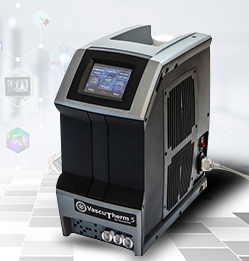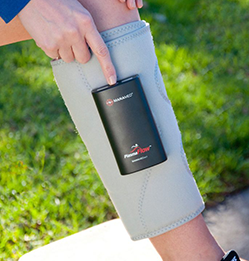
Cold Therapy Use
The Vascutherm machine with body part wrap provides cold therapy in combination with pneumatic compression therapy for the management of pain, discomfort and swelling. Temperature range 43 degrees F to 49 degrees F.
DVT Calf Use
Vascutherms with DVT Prophylaxis help prevent DVT’s — What is a DVT?
- A deep vein thrombosis, or DVT, is a blood clot that occurs in a vein. A vein is a type of blood vessel that carries oxygen-poor blood back to the heart (versus arteries, which are blood vessels that carry oxygen-rich blood throughout your body).
- DVT blood clots usually occur in the leg, though they can occur in the arm or other veins. The clot can block blood flow and lead to painful swelling in the affected limb. A DVT may also lead to a pulmonary embolism (PE), which happens when a DVT blood clot breaks off and travels through the bloodstream to the lungs.
- It’s important to recognize what the DVT symptoms are so you can see your healthcare professional immediately to begin treatment. Symptoms of DVT include: swelling of the leg or affected area, pain or tenderness at rest or when standing or walking, skin that is warm to the touch, and/or skin that is red or discolored
What does the Vascutherm with DVT Prophylaxis do?
- DVT Compression therapy is used in combination with specially designed therapy wraps to transfer pressure to the calf or foot using compressed air. The preset inflation and deflation cycle of the VascuTherm 5 therapy system simulates natural walking action. This increases blood flow to the heart through the veins of the lower extremities to reduce the risk of clot formation.
- For more information, click here to view a brochure that explains it in detail.
FAQs
Where should I place the machine?
The unit should only be placed on the floor. Please do not place the unit on a table top
The Vascutherm requires proper air flow in order to operate; please do not place the unit next to a space heater and allow at least one foot of space between it and any furniture or wall.
How do I know if the cords are connected properly?
You should hear a ‘click’ when connecting the umbilical to the unit and to your wrap. To ensure good circulation of fluid through the unit, ensure that each connection is fully and properly joined. The umbilical and tubes should not be kinked or bent.
Do I need to check the fluid levels?
In order to keep fluid levels at the proper volume, you should check the level in the reservoir every morning. The unit must be running a cold therapy cycle before you can remove the cap. The fluid should reach the base of the reservoir’s neck and be maintained at this level. Ensure that the cap is replaced and gently tightened. This ensures that leaking will not occur when the cycle has ended.
Change Profile
How I do I change profiles?
If the equipment provider has instructed you to change the treatment profile after some period of therapy duration, from the ACTIVE THERAPY screen, press the NEXT key.
- The THERAPY CHANGE screen will be displayed as shown below.

- Press the Profile Select key.
- The PROFILE SELECT screen will be displayed as shown below.

- The controller can store up to three therapy profiles. The current profile is displayed in gold with its settings below in white.
- Select the profile number instructed by the provider. Review the profile settings to match the information provided by the provider.
- Press the ACCEPT key to accept the new treatment profile.
The Profile window in the THERAPY ACTIVE screen will update to show the new profile section.
Quiet Mode
How do I turn on Quiet Mode?
The VascuTherm 5 controller has a mode to set the fans to QUIET mode.
- To access this mode, from the THERAPY ACTIVE SCREEN, press the Next key twice. If the QUIET MODE has been enabled by the equipment provider, the option to set it will be visible on the screen as shown.

- Press on the Quiet Mode key.
- The Quiet Mode selection screen will be displayed. Press the UP or DOWN arrows to set the “New Setting” to Quiet. Press the Accept key.

- You will notice the fans operating in quiet mode. Please note, the controller will continue to monitor the thermal therapy temperature, and if required will enter the high fan speed mode to provide the prescribed treatment.
Troubleshooting
Low Coolant Warning
- STEP 1: Ensure the cycle is still running even though there is a warning message. The fluid should still be circulating through the wrap. Have the refill bottle ready.
- STEP 2: Remove the cap and continue filling the device until the coolant level stabilizes at the base of the reservoir’s neck.
- STEP 3: Once there is sufficient fluid in the device, screw the cap back on. Then press Accept. This will return you to the profile screen for the current cycle.
Note: There is a timer on the alert message. If the fluid isn’t added in time, the cycle will stop and there will be backflow into the reservoir and may cause spillage. If this happens, refer to the section below.
Cycle turned off because of low coolant.
- STEP 1: Press Accept. This will return you to the home screen.
- STEP 2: Remove Cap and look inside. It may appear to have sufficient coolant, but coolant has not yet filled the wrap. Refill to the top of the reservoir.
- STEP 3: Have a full bottle of coolant prepared. Press start. The circulation pump will begin in about 3 seconds. When it does, the coolant level will drop rapidly. This is your cue to fill the reservoir. Pour quickly to pace the pumping action of the unit. Continue filling the unit until the coolant level stabilizes at the base of the reservoir’s neck.
- The machine turns off.
SCENARIO 1: Low Coolant
SOLUTION: Follow instructions on fixing low-coolant (see above section on “Low Coolant Warning”).
SCENARIO 2: Low Temperature Warning (e.g. – Machine was left in the garage.)
SOLUTION: Press Accept and then press Start.
- The machine is leaking.
SCENARIO 1: The cap is improperly threaded. If the cap is not threaded properly and tight, when the therapy session is done water can leak from the top of the machine.
SOLUTION: Ensure cap is threaded on properly AND is tight enough.
SCENARIO 2: Black rubber gasket in the cap is upside down or bowed from age.
SOLUTION: Request a new cap from your fitter or contact PremiereMed for a new cap.
SCENARIO 3: Black umbilical hose is not properly and completely inserted into the machine.
SOLUTION: Remove ends and reinsert them into the unit.
SCENARIO 4: There is an internal leak.
SOLUTION: Request new unit from fitter/PremiereMed. A fitter can be sent out to exchange units. A working unit can also be shipped via UPS/Fedex and the leaking unit can be returned to PremiereMed in the box provided.
- I’m getting a “Manifold Temp Low Limit” warning.
This warning occurs due to a circulation issue. The water is not flowing properly through the unit.
SCENARIO 1: The cords are not connected properly.
SOLUTION: Select "Accept" and turn off the unit. Disconnect the umbilical cord on both ends. Reconnect making sure none of the cords are bent. Turn the unit on and restart the cycle. If warning comes up again, see "SCENARIO 2" below.
SCENARIO 2: THE CAP is on too tight.
SOLUTION: Select "Accept" and turn off the unit. Unscrew the cap (NOTE: Have a towel on hand as there will be backflow when you remove the cap, this is normal. You will need to add additional fluid when you restart the cycle.) Look at the cap to make sure the inner seal (black rubber inside the cap) is not warped or damaged. Put the cap on being careful to not over tighten. Turn the unit on and restart the cycle. If the warning comes up again, please call the number on the front of the unit or on our Contact Us page.

DVT Calf Use
Mobile DVT Devices help prevent DVT - What is a DVT?
- A deep vein thrombosis, or DVT, is a blood clot that occurs in a vein. A vein is a type of blood vessel that carries oxygen-poor blood back to the heart (versus arteries, which are blood vessels that carry oxygen-rich blood throughout your body).
- DVT blood clots usually occur in the leg, though they can occur in the arm or other veins. The clot can block blood flow and lead to painful swelling in the affected limb. A DVT may also lead to a pulmonary embolism (PE), which happens when a DVT blood clot breaks off and travels through the bloodstream to the lungs.
- It’s important to recognize what the DVT symptoms are so you can see your healthcare professional immediately to begin treatment.
Symptoms of DVT include: swelling of the leg or affected area, pain or tenderness at rest or when standing or walking, skin that is warm to the touch, and/or skin that is red or discolored
How do mobile DVT devices help prevent DVT?
- Mobile DVT devices aid in the prevention of Deep Vein Thrombosis (DVT) by helping to stimulate blood flow in the legs. This is accomplished by an electronically controlled pump delivering a set amount of air to the leg cuffs that, in turn, compress the calf or calves to aid blood flow out of the lower extremities. The pump will inflate each leg cuff to a pre-set pressure and deflate once the pressure is reached. The cycles are repeated on each unit until the power is turned off. Internal rechargeable batteries allow the device to be completely portable, thus preventing interruptions in treatment.
Troubleshooting
Coming soon
